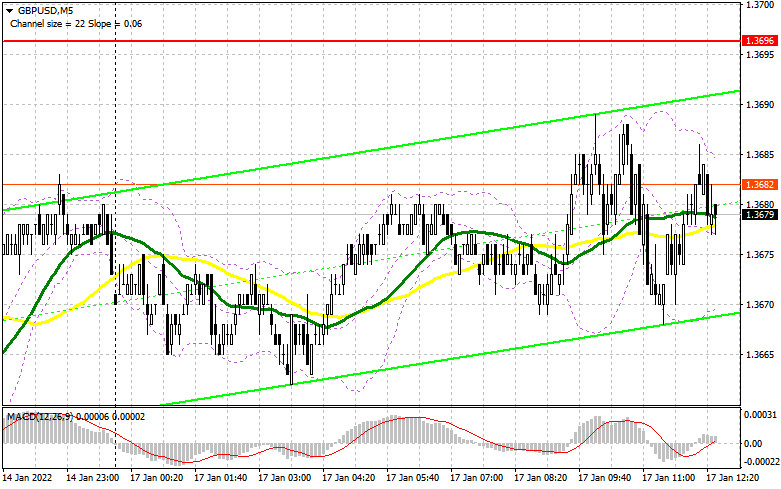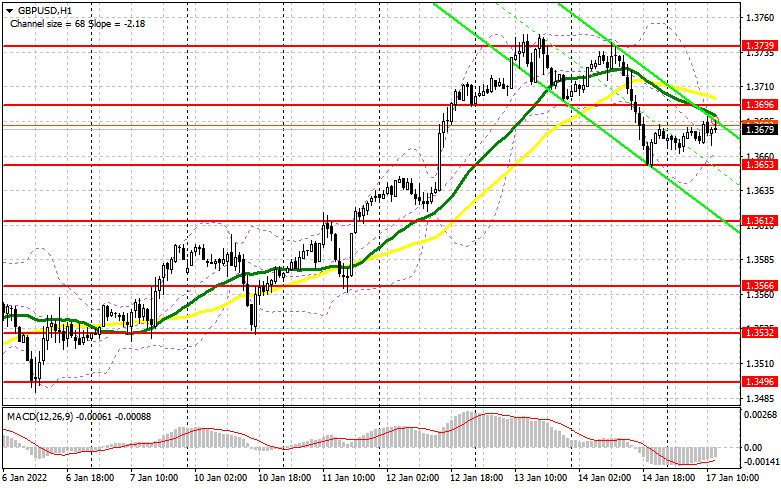
To open long positions on GBP/USD, you need:
In my morning forecast, I paid attention to several levels, but due to excessively low volatility, we never managed to get to them. Let's look at the 5-minute chart and figure out what happened. Due to the lack of tests 1.3653 and 1.3696, no entry points were formed into the market, and apparently, a similar picture will remain for the second half of the day. Buyers of the pound will certainly make another attempt to reach the resistance of 1.3696, but it will be extremely problematic to break above this range. The technical picture and strategy for the second half of the day have not changed in any way. And what were the entry points for the euro this morning?

A slight slowdown in the upward trend in the pound will only play on the side of buyers who needed this correction and a small pause observed at the beginning of this week. The main goal of the bulls for today, given that there are no fundamental statistics, remains the return to control of the resistance of 1.3696, where the moving averages are playing on the side of the sellers of the pound. At this level, buyers will be maximally targeted in the afternoon. No less important task is also the protection of the 1.3653 support, which was formed following the results of last Friday. The formation of a false breakdown at 1.3653 forms a buy signal with the prospect of resuming the bull market aimed at growth above 1.3696. Only a breakdown and a test of this level from top to bottom will give an additional entry point, which will strengthen the position of buyers to return to the monthly maximum of 1.3739. A more distant target will be the 1.3790 area, where I recommend fixing the profits. In the scenario of a decline in GBP/USD during the US session and a lack of activity at 1.3653, it is best to postpone purchases to the level of 1.3612, from where it will be possible to observe more aggressive actions of bulls – this is their last chance to keep the market under their control in the short term. To miss this area is tantamount to missing the initiative. Only the formation of a false breakdown at 1.3612 will give an entry point in the expectation of further recovery of GBP/USD. You can buy the pound immediately on a rebound from 1.3566, or even lower - from a minimum of 1.3532, counting on a correction of 20-25 points within a day.
To open short positions on GBP/USD, you need:
Bears have taken a break so far and are in no hurry to return the pair to the minimum of last Friday, clearly realizing that any rash actions will only increase the appetite of buyers of the pound who were late for the "outgoing train" last week. The primary task of the bears for today remains the protection of a rather important resistance of 1.3696, just above which the moving averages are playing on the side of sellers. Only the formation of a false breakdown at this level forms the first entry point into short positions against an uptrend, followed by a decline in the pair to the area of 1.3653, which was the result of a correction at the end of last week. Taking control of this level will give a new entry point into short positions with the prospect of a decline in GBP/USD by 1.3612 and 1.3566, where I recommend fixing the profits. If the pair grows during the American session and sellers are weak at 1.3696, it is best to postpone sales until the next major resistance at 1.3739. I also advise you to open short positions there only in case of a false breakdown. You can sell GBP/USD immediately for a rebound from 1.3790, or even higher - from a new high in the area of 1.3842, counting on the pair's rebound down by 20-25 points within a day.

The COT reports (Commitment of Traders) for January 4 recorded a sharp increase in long positions and a reduction in short positions - which indicates an increase in the attractiveness of the pound after the Bank of England raised interest rates at the end of last year. If you look at the overall picture, the prospects for the British pound look pretty good. The decisions of the Bank of England continue to support buyers of risky assets in the expectation that the regulator will continue to raise interest rates this year, which will make the pound even more attractive. High inflation remains the main reason why the Bank of England will continue to tighten its monetary policy. On the other hand, the US dollar also has support: inflation data in the US are expected this week, which, together with the recent report on the US labor market, will certainly force the Federal Reserve to act more aggressively. The first interest rate hikes are planned in the spring, which will make the US dollar more attractive. The COT report for January 4 indicated that long non-commercial positions rose 20,824 to the level of 25,980, while short non-commercial positions fell from the level of 78,510 to the level of 65,151. This led to a serious change in the negative non-commercial net position from -57,686 to -39,171. The weekly closing price rose from 1.3209 to 1.3482.
Signals of indicators:
Moving averages
Trading is conducted below 30 and 50 daily moving averages, which indicates a downward correction of the pound in the short term.
Note: The period and prices of moving averages are considered by the author on the hourly chart H1 and differ from the general definition of the classic daily moving averages on the daily chart D1.
Bollinger Bands
A breakthrough of the upper limit of the indicator in the area of 1.3680 will lead to a new wave of growth of the pound. In case of a decline, the lower limit of the indicator in the area of 1.3660 will act as support.
Description of indicators
Moving average (moving average determines the current trend by smoothing out volatility and noise). Period 50. The graph is marked in yellow.Moving average (moving average determines the current trend by smoothing out volatility and noise). Period 30. The graph is marked in green.MACD indicator (Moving Average Convergence / Divergence - moving average convergence/divergence) Fast EMA period 12. Slow EMA period 26. SMA period 9Bollinger Bands (Bollinger Bands). Period 20Non-profit speculative traders, such as individual traders, hedge funds, and large institutions that use the futures market for speculative purposes and meet certain requirements.Long non-commercial positions represent the total long open position of non-commercial traders.Short non-commercial positions represent the total short open position of non-commercial traders.Total non-commercial net position is the difference between the short and long positions of non-commercial traders.